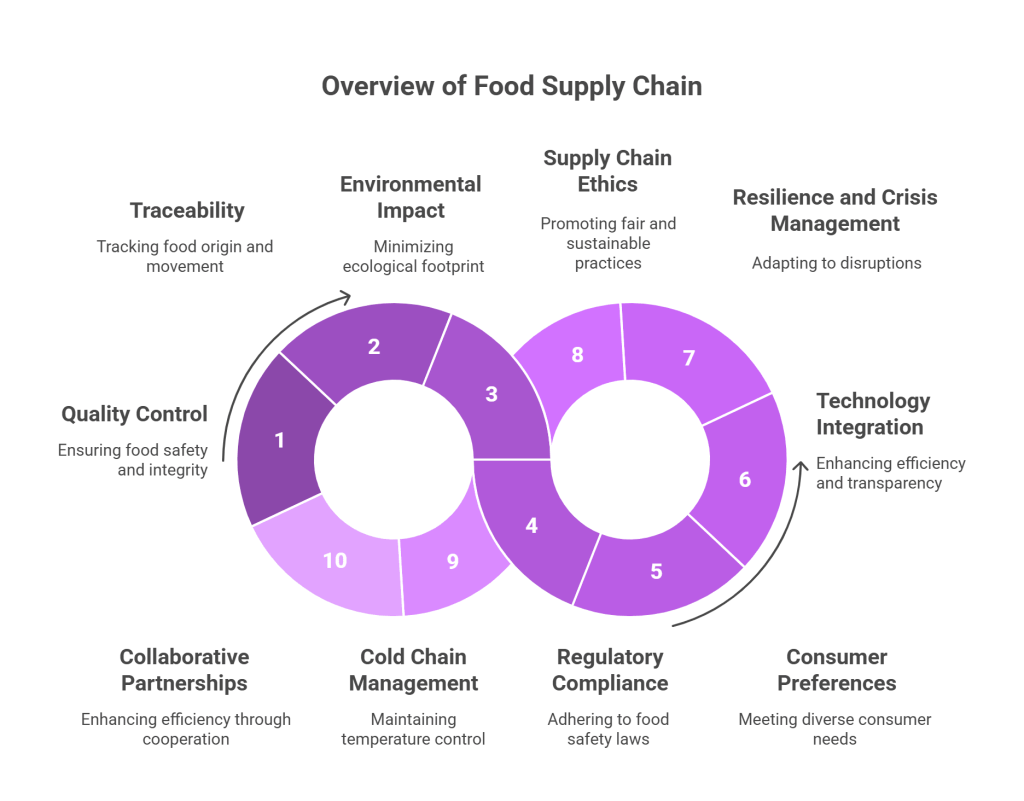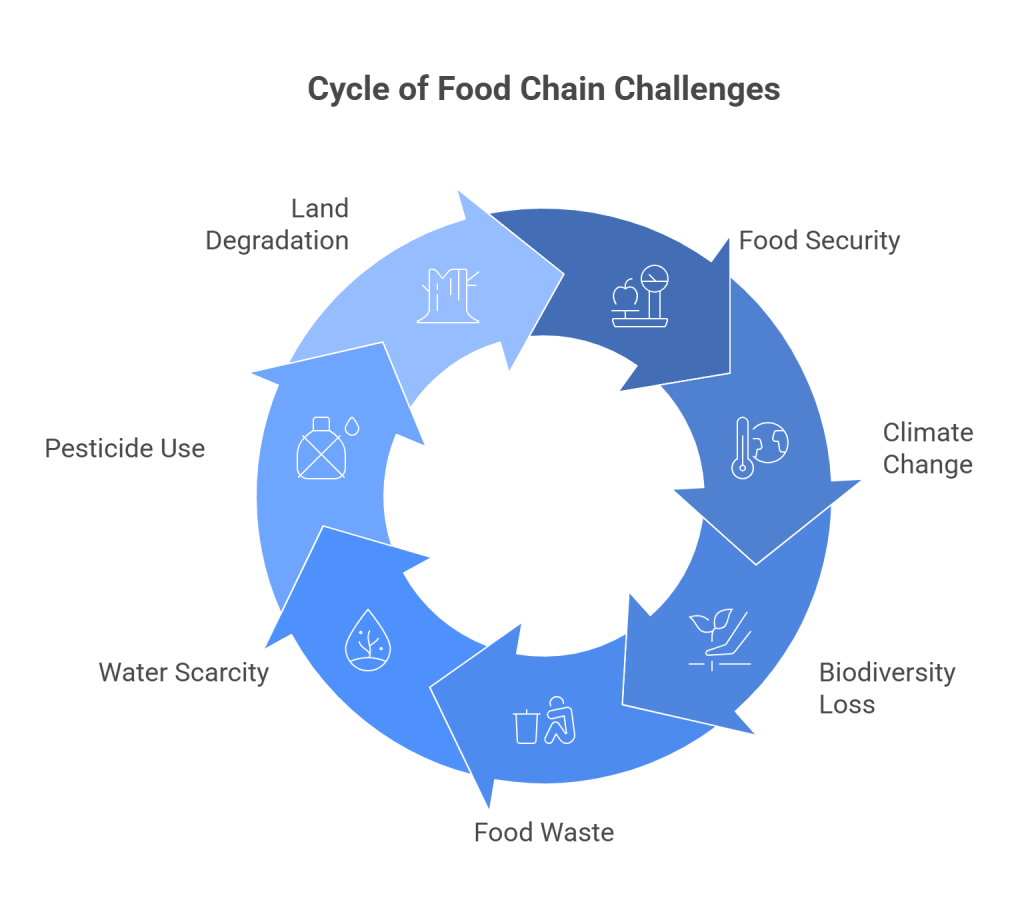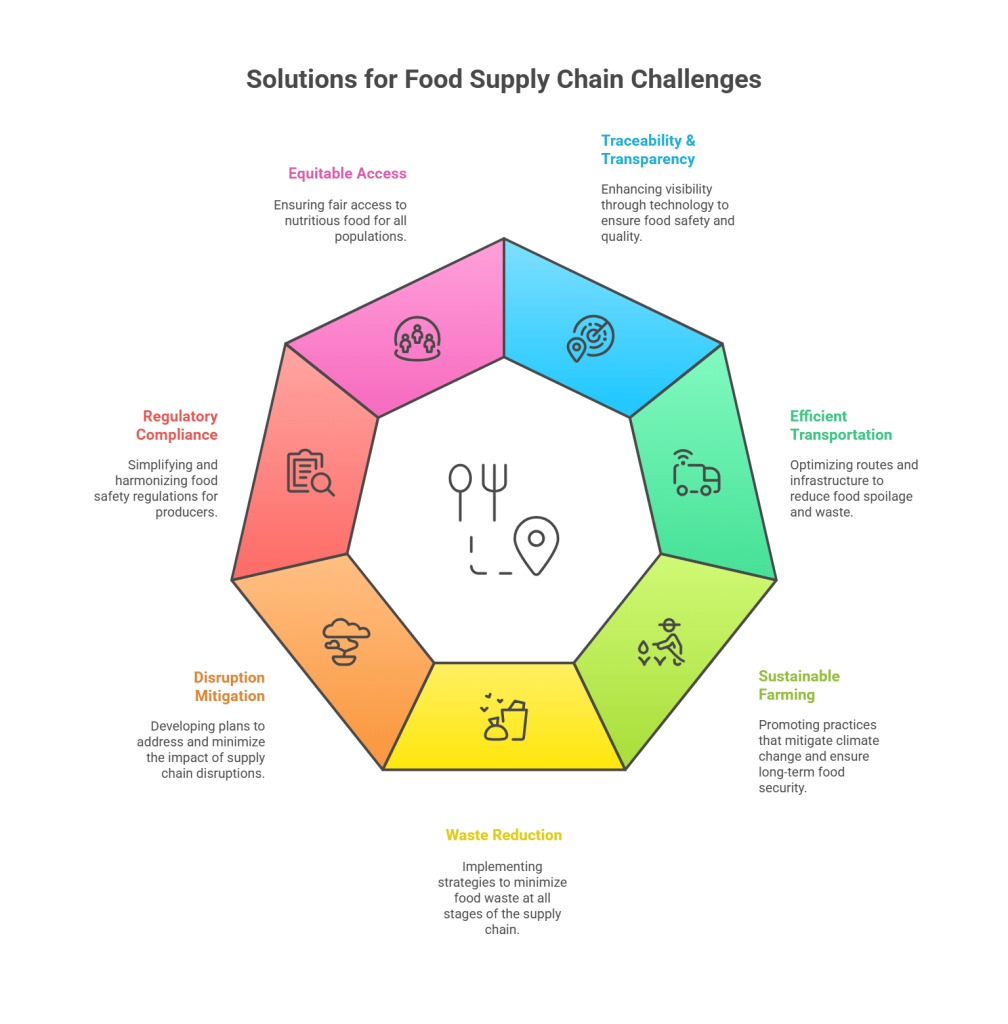In the complex web of modern commerce, the food supply chain stands as a pivotal lifeline, linking farmers, manufacturers, distributors, and consumers. What is the Food Supply Chain? may seem like a straightforward question, but in the ever-evolving landscape of 2023, it’s a query that demands a nuanced response. This intricate network, responsible for the journey of sustenance from field to fork, faces unprecedented challenges today.
Factors like climate change, global pandemics, and shifting consumer demands have exposed vulnerabilities in this critical system. In this blog, we’ll delve deep into the intricacies of the food supply chain, uncover the pressing challenges it confronts, and explore innovative solutions that aim to secure our food future.

Overview of Food Supply Chain

The food supply chain is a complex and intricate network of processes and activities that span from the production and cultivation of raw ingredients to the delivery of final food products to consumers’ plates.
This multifaceted system involves various stakeholders, including farmers, producers, distributors, retailers, and consumers, all working together to ensure a steady flow of safe and nutritious food. The food supply chain is critical for sustaining human life and well-being, making it a fundamental component of global economies and societies. Listed below are the key features of the food supply chain :
1. Quality Control
Maintaining rigorous quality control measures is essential to ensure the safety and integrity of the food supply. This involves monitoring and managing factors such as hygiene, contamination risks, and product specifications at each stage of the supply chain. Regulatory agencies, industry standards, and certifications like ISO 22000 and HACCP (Hazard Analysis and Critical Control Points) are crucial in upholding these standards.
2. Traceability
Traceability is the ability to track the origin and movement of food products throughout the supply chain. It’s essential for quickly identifying and recalling contaminated or unsafe products. Technologies like barcodes, RFID (Radio-Frequency Identification), and blockchain have been adopted to enhance traceability and transparency.
3. Environmental Impact
The food supply chain is closely linked to environmental concerns, such as land use, water consumption, and greenhouse gas emissions. Sustainable practices, such as organic farming, responsible sourcing, and reduced food waste, are gaining prominence as the industry seeks to minimize its ecological footprint.
4. Regulatory Compliance
Food safety and labeling regulations vary from one region to another. Compliance with these regulations is paramount to avoid legal and reputational risks. Businesses operating in the food supply chain must navigate a complex web of regulations, including those related to labeling, nutritional content, and food additives.
5. Consumer Preferences
Consumer preferences for food products are diverse and continually evolving. Factors like dietary trends, cultural influences, and health considerations impact what consumers choose to purchase. Understanding and responding to these preferences is crucial for businesses within the food supply chain.
6. Technology Integration
The food supply chain has increasingly adopted technology solutions to enhance efficiency and transparency. This includes the use of data analytics for demand forecasting, automation in food processing, and real-time monitoring of transportation and storage conditions.
7. Resilience and Crisis Management
The food supply chain must be resilient to various disruptions, such as natural disasters, supply chain interruptions, and public health crises like pandemics. Planning, contingency measures, and risk assessment are vital for ensuring that the supply chain can adapt to unexpected challenges and continue providing food to consumers.
8. Supply Chain Ethics
Ethical considerations have gained prominence in the food supply chain. Issues such as fair labor practices, animal welfare, and sustainable sourcing have become crucial for both consumers and businesses. Ethical certifications, like Fair Trade and Certified Humane, help address these concerns and influence consumer purchasing decisions.
9. Cold Chain Management
Many food products, such as fresh produce, dairy, and frozen goods, require precise temperature control throughout the supply chain to maintain quality and safety. Cold chain logistics, which involve refrigerated storage and transportation, are essential for preventing spoilage and ensuring that products reach consumers in optimal condition.
10. Collaborative Partnerships
Collaboration and cooperation among supply chain participants are increasingly important. Partnerships can enhance efficiency and reduce waste by sharing information and resources. Collaborative initiatives may involve joint product development, shared transportation networks, or coordinated efforts to address supply chain challenges like food recalls or sustainability initiatives.
In summary, the food supply chain is a multifaceted and interconnected system with numerous features that shape its complexity and importance. It encompasses diverse participants, manages seasonal variability, operates on a global scale, adheres to quality control standards, focuses on traceability, addresses environmental concerns, complies with regulations, caters to consumer preferences, integrates technology, and maintains resilience in the face of disruptions. These features collectively ensure a safe, reliable, and sustainable flow of food from producers to consumers.
Importance of Food Chain

The food chain is a fundamental ecological concept that illustrates the flow of energy and nutrients through an ecosystem, connecting various organisms based on their feeding relationships. Its significance is multifaceted and plays a pivotal role in maintaining ecological balance and sustaining life on Earth. Here are the key significances of the food chain:
1. Energy Flow:
The food chain illustrates the unidirectional flow of energy within ecosystems. Primary producers (plants) capture solar energy through photosynthesis, converting it into chemical energy in the form of carbohydrates. Herbivores consume these plants, and carnivores, in turn, prey on herbivores. This energy transfer is essential for all life processes, from growth and reproduction to locomotion and maintenance.
2. Nutrient Cycling:
Beyond energy, food chains depict the circulation of vital nutrients. When organisms die or produce waste, their remains release nutrients back into the environment. These nutrients are absorbed by plants, restarting the cycle. This nutrient recycling sustains the health and productivity of ecosystems.
3. Biodiversity Maintenance:
Food chains showcase the intricate web of life, emphasizing the interdependence among species. The diversity of organisms in a food chain is crucial because each species plays a unique role. Loss of one species can have cascading effects on others, potentially destabilizing the entire ecosystem.
4. Predator-Prey Dynamics:
Food chains reveal predator-prey relationships, demonstrating how populations of predators and prey fluctuate over time. This dynamic interaction helps control population sizes and prevents any one species from dominating an ecosystem. It also promotes adaptations and behaviors that enhance survival.
5. Ecosystem Stability:
Food chains contribute to ecosystem stability by regulating species populations. They prevent the overgrowth of herbivores, which could otherwise decimate plant populations, and the unchecked multiplication of herbivores, which would negatively impact plant communities.
6. Indicator of Environmental Health:
Changes in food chains can serve as early warning signs of environmental disturbances. If a particular species disappears from a food chain, it may indicate pollution, habitat loss, or other ecological issues that require attention.
7. Human Impact:
Understanding food chains is crucial for managing human impacts on ecosystems. Overfishing, deforestation, and pollution can disrupt these chains, affecting not only the targeted species but also numerous others connected to them.
8. Conservation:
Conservation efforts often focus on protecting key species within food chains, as saving a top predator, for example, can indirectly safeguard numerous other species in the chain. This approach helps preserve overall ecosystem health.
9. Education:
Food chains are a valuable educational tool, helping people, especially students, understand complex ecological relationships. They foster an appreciation for the natural world and the importance of biodiversity conservation.
10. Global Balance:
Food chains are interconnected on a global scale, emphasizing the interdependence of ecosystems worldwide. Changes in one region can impact food chains and ecosystems in distant places, highlighting the global responsibility for environmental stewardship.
In summary, the food chain is a fundamental concept in ecology that provides insights into energy flow, nutrient cycling, biodiversity maintenance, and the delicate balance of nature. Understanding its significance is essential for informed conservation and sustainable management of Earth’s ecosystems.
Food Chain Problems We Need to Consider

The global food chain faces numerous challenges that demand immediate attention and sustainable solutions. These issues encompass various aspects of food production, distribution, and consumption, affecting both people and the environment. The top problems in the food chain that we need to consider are:
1. Food Security and Hunger
Food security is the foundation of a sustainable food chain. Despite advances in agriculture and food production, millions of people still suffer from hunger and malnutrition. This problem is exacerbated by inequalities in access to food, income disparities, and conflicts that disrupt food distribution. Achieving food security involves addressing these systemic issues, ensuring equitable access to nutritious food for all, and building resilience to food crises.
2. Climate Change and Agriculture
Climate change is a critical threat to food production. Rising temperatures, altered precipitation patterns, and increased frequency of extreme weather events can lead to crop failures and reduced yields. Adaptation strategies, such as developing drought-resistant crops and sustainable farming practices, are essential to mitigate these risks. Furthermore, the food industry must work to reduce its greenhouse gas emissions, as agriculture is a significant contributor to climate change.
3. Loss of Biodiversity
Modern agricultural practices often rely on monocultures, where a single crop is cultivated over extensive areas. This can lead to the depletion of soil nutrients and increased vulnerability to pests and diseases. Additionally, monocultures can contribute to the loss of biodiversity as they replace natural ecosystems. Promoting biodiversity in agriculture through crop rotation, agroforestry, and organic farming methods can help maintain ecological balance and resilience.
4. Food Waste
Food waste is a critical issue in the food chain. A substantial portion of food is lost at various stages, from production and transportation to retail and consumption. Addressing food waste requires efforts to improve supply chain efficiency, educate consumers on reducing waste, and redirect surplus food to those in need. Reducing food waste not only conserves resources but also helps alleviate hunger and reduces greenhouse gas emissions from decomposing food.
5. Water Scarcity and Agriculture
Agriculture is a major consumer of freshwater resources. The unsustainable use of water for irrigation can deplete aquifers and lead to water scarcity, especially in regions facing water stress. Sustainable water management practices, such as drip irrigation and rainwater harvesting, are essential to reduce water consumption in agriculture and ensure the availability of water for future generations.
6. Pesticide and Chemical Use
The heavy use of pesticides and synthetic chemicals in agriculture can have detrimental effects on the environment, including soil degradation, water pollution, and harm to non-target species. Transitioning towards organic farming methods and integrated pest management can reduce the reliance on harmful chemicals while maintaining crop yields and soil health.
7. Land Degradation and Deforestation
Expanding agricultural land often leads to deforestation and land degradation, which diminishes natural habitats and contributes to climate change. Sustainable land use practices, such as reforestation, afforestation, and conservation efforts, are crucial to mitigate these issues and protect valuable ecosystems.
Addressing these problems in the food chain requires collaborative efforts from governments, farmers, consumers, and the food industry. Sustainable and resilient food systems that prioritize both environmental protection and food security are essential for a healthier and more equitable future.
Solutions for Overcoming Food Supply Chain Problems

The global food supply chain faces a myriad of challenges that can lead to inefficiencies, waste, and food insecurity. Addressing these issues requires a multi-faceted approach that involves stakeholders at every level of the supply chain.
Effective solutions include implementing advanced technology for better traceability, promoting sustainable agricultural practices, investing in infrastructure and transportation networks, fostering collaboration among supply chain participants, reducing food waste through improved storage and distribution, supporting small-scale and local food production, and enhancing transparency in the supply chain through data-sharing and monitoring. Listed below are the top solutions one can consider to overcome food supply chain problems.
1. Lack of Traceability and Transparency
A significant challenge in the food supply chain is the lack of traceability and transparency. This problem hinders the ability to quickly identify the source of contamination outbreaks, food fraud, or quality issues. Blockchain and advanced tracking systems can address this by providing real-time visibility into the movement of products, enabling swift responses to problems.
2. Inefficient Transportation and Distribution
Inefficient transportation and distribution networks can result in food spoilage and waste. Upgrading infrastructure, optimizing routes, and adopting refrigeration and packaging technologies can help reduce these losses and improve overall efficiency.
3. Climate Change and Environmental Factors
Climate change disrupts agricultural patterns and can lead to unpredictable weather events and crop failures. Promoting sustainable farming practices, such as drought-resistant crops and precision agriculture, can mitigate these issues and enhance long-term food security.
4. Food Waste
Food waste is a significant problem throughout the supply chain, from production to consumption. Implementing better inventory management, donation programs for surplus food, and educating consumers about food storage and expiration dates can reduce waste.
5. Supply Chain Disruptions
Natural disasters, pandemics, and geopolitical tensions can disrupt the supply chain, leading to shortages and price fluctuations. Developing contingency plans and diversifying sourcing can help mitigate these disruptions.
6. Complex Regulatory Compliance
Compliance with various food safety regulations and standards can be complex, especially for small-scale producers. Simplifying and harmonizing regulations, providing education and resources, and supporting local food systems can address this issue.
7. Inequities in Access to Food
Food insecurity persists globally, with unequal access to nutritious food. Supporting small-scale farmers, investing in agricultural development in underserved regions, and creating social safety nets can help reduce disparities in access to food.
Addressing these food supply chain problems requires collaboration among governments, businesses, and civil society. Implementing innovative solutions, sustainable practices, and fostering resilience will be crucial in building a more secure and efficient global food supply chain.
Conclusion
In conclusion, the food supply chain in 2023 faces numerous challenges, from climate change and resource scarcity to increased demand and supply chain disruptions. However, innovative solutions like Qodenext offer a lifeline.
With its advanced technology and data-driven approach, Qodenext can help streamline and optimize the food supply chain, ensuring food security and sustainability for the future. Take action today – contact Qodenext and join the movement towards a more resilient and efficient food supply chain.
FAQs – Understanding the Food Supply Chain
1. What is the food supply chain and why is it important?
The food supply chain refers to the entire journey of food from farms to consumers’ plates, involving stages like production, processing, distribution, storage, and retail. It’s crucial as it ensures a continuous flow of safe, nutritious, and accessible food, supporting global health, economies, and food security.
2. What are the major challenges facing the food supply chain today?
Key challenges include climate change, food waste, lack of transparency, water scarcity, inefficient distribution, biodiversity loss, overuse of chemicals, and regulatory complexities. These issues disrupt efficiency and threaten food security globally.
3. How does climate change impact the food supply chain?
Climate change affects crop yields, disrupts growing seasons, and increases the frequency of extreme weather events like floods and droughts. This makes agricultural production unpredictable and intensifies risks in food storage, sourcing, and transportation.
4. Why is traceability important in the food supply chain?
Traceability ensures that food can be tracked through all stages of production and distribution. It’s vital for food safety, efficient recalls during contamination, minimizing fraud, and building consumer trust. Technologies like RFID and blockchain are revolutionizing this process.
5. What role does technology play in strengthening the food supply chain?
Technology helps enhance efficiency, visibility, and resilience. Innovations like IoT, blockchain, RFID, data analytics, and automation improve monitoring, forecasting, cold chain management, and reduce spoilage and waste.
6. How does food waste affect the supply chain?
Food waste contributes to economic loss, resource depletion, and greenhouse gas emissions. It occurs at all stages—production, storage, retail, and consumption. Reducing waste improves efficiency, conserves resources, and helps combat hunger.
7. What is cold chain management and why is it critical?
Cold chain management involves maintaining temperature-controlled storage and transportation for perishable items like dairy, meat, and frozen foods. This protects food quality and safety, preventing spoilage and financial loss.
8. How can small-scale farmers benefit from supply chain innovations?
Small-scale farmers can leverage modern tools for weather forecasting, market access, traceability, and sustainable practices. With the right support, they can improve yields, gain fair market prices, and contribute to food security.
9. What sustainable solutions can improve the global food supply chain?
Key solutions include promoting regenerative agriculture, reducing emissions, improving water use, minimizing food waste, investing in rural infrastructure, supporting ethical sourcing, and integrating digital technologies for transparency and efficiency.
10. How can companies like Qodenext help solve food supply chain issues?
Qodenext provides advanced technological solutions for real-time traceability, automation, inventory control, and data-driven decision-making. Their services help reduce losses, ensure compliance, and improve overall resilience and sustainability of the food supply chain.







